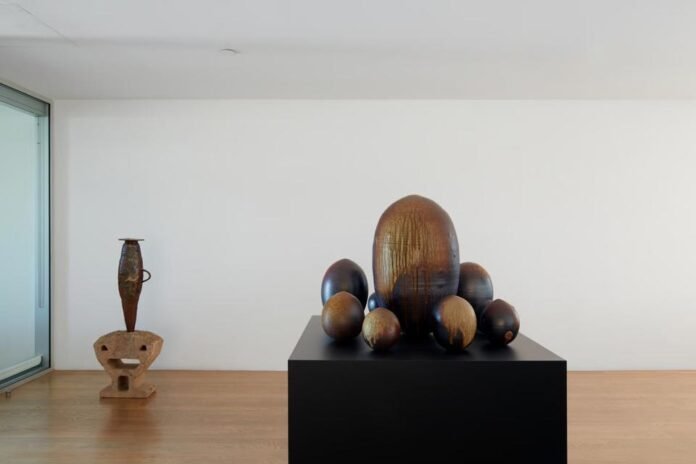LACMA Seeds and Weeds, Installation view, Los Angeles, 2025,
Ceramics has long oscillated between the functional and the artistic. California has a long tradition of makers who span the chasm between the two, from Beatrice Wood to Jonathan Adler.
Among the LA ceramic artists who began making functional pottery and who, in the last decades, migrated to increasingly conceptual artworks is Adam Silverman, who has a show of new work, LACMA Seeds and Weeds, at BLUM in LA on view until August 16, 2025. (BLUM recently announced they will be closing the gallery, so see this while you can).
Silverman’s early background was in architecture, and he takes special care in how his work is displayed. In the Blum galleries, Silverman has grouped certain pieces that take on additional totemic power together, as well as individual pieces that stand out, positioned around the room, on the floor, on a platform, or on a shelf. Silverman’s placement of his work is akin to how a Zen gardener places his rocks, contextualizing the work as worthy of contemplation.
Silverman was the 2024 artist in residence at the Skirball Cultural Center, where he showcased his installation Common Ground, a conceptual work for which Silverman collected clay, water, and wood ash from all fifty American states, as well as from Washington DC, and the US Territories of Puerto Rico, the US Virgin Islands, Guam, American Samoa, and the Northern Mariana Islands to make the glazes. The final exhibition includes a tableware set of fifty-six plates, fifty-six bowls, fifty-six cups, as well as fifty-six ceremonial pots.
For his exhibition at Blum, Silverman has spent the last five and a half years collecting materials from the LACMA demolition, which he refers to as the “oozing, living history of the city.” Silverman used the materials to make the glazes; he also would blow matter into the kiln while it’s superhot in a manner that affects the surfaces of the pottery. Finally, actual demolition debris was incorporated into the pieces. The total effect does not say LACMA, but rather speaks to the primordial location, sitting as it does near the Tar Pits.
LACMA Seeds and Weeds, Installation view, Los Angeles, 2025.
Play Puzzles & Games on Forbes
Some of the works grouped together, which Silverman calls “seeds,” look like fossilized dinosaur eggs that have bubbled up from the tar pits. Silverman calls other works on display, “weeds,” as if they sprung from the seeds. Some of the works recall ancient amphora, others are objects that emanate a certain ancient power as if used once for ritual or commemorative reasons.
The borders between ceramics, sculpture and painting are increasingly porous. At one end of the spectrum are participants in the “Maker” culture a DYI aesthetic powered by the lowering of barriers to entry for object making. At the other end are artists engaging with ancient mediums whose possibilities have been enhanced by technology. Silverman’s works speak to place, time, history, and our emotional connection to the objects derived from specific sites.
The source of Silverman’s site-specific additives is not apparent when you look at the works. Yet they do add a conceptual and metaphorical dimension that enhances our connection to the work.
Silverman’s ceramics both delight us and haunt us because we know they are man-made and yet contain primordial history.







